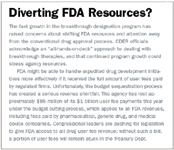Biopharma Innovation in Trouble?
Rising costs will mean a drop in anticipated NDAs next year, reflecting an ever-longer and more costly drug-development process that is squeezing pharma investment in R&D.
User fees are going up because it takes more time and resources for the Food and Drug Administration to review applications for more complex products—and because the volume of new drug applications (NDAs) is going down. The dip is slight for submissions expected in 2014, according to an announcement of Prescription Drug User Fee Act (PDUFA) rates published in the Federal Register Aug. 2. FDA expects to see 116 filings in 2014, slightly less than the 122 submissions in 2012. And because the agency has to collect a certain amount of fee revenues each year, which is revised to reflect inflation and a "workload adjuster" for the new drug review program, fewer submissions means that each sponsor pays a little more.

Jill Wechsler
So next year it will cost $2.2 million to submit an NDA or biologics license application (BLA) for agency review, and $1 million for a supplement with clinical data, generally to support new indications or expanded labeling. Review of a new biosimilar application that carries clinical data will be just as costly.
While a $2 million application fee may be relatively inconsequential for a large pharma company, compared to the vast sums it spends on clinical trials and product development, the amount may be considerable for small firms with limited resources. Manufacturers moreover will pay higher establishment fees ($555,000 for each of 455 facilities) and product fees ($104,000 for 2,425 marketed products).
Boosting breakthroughs
The drop in anticipated NDAs may reflect an ever-longer and more costly drug-development process that is squeezing pharma investment in R&D. FDA has a ways to go to approve as many new molecular entities (NMEs) in 2013 as the near-record 39 NMEs in 2012, and maintaining momentum will be harder in the future if initial submissions drop. Of course, if sponsors file more high-quality applications that yield a greater percentage of approvals, the final numbers could continue to rise—an outcome that would bring cheers on all sides.
A more positive view of the approvals-and-innovative issue is to distinguish truly important NMEs—"first-in-class" and "advance-in-class" medicines that account for a growing proportion of new drugs—from "addition-to-class" drugs that are declining, according to FDA analysis (http://bit.ly/197KlG6). A rising number of advanced new therapies are coming to market, according to this assessment, even if total approvals remain static.

Diverting FDA Resources?
FDA's new breakthrough drug program promises to support this shift by speeding the development and authorization of promising, critical therapies. Not only will FDA accelerate the review of applications for therapies that win the "breakthrough" designation, but agency scientists will provide advice and leeway to streamline clinical development. According to Friends of Cancer Research, a lead advocate for the program, FDA received 73 requests for breakthrough status as of late July—much more than the handful initially expected. The designation has been denied for 22 requests and granted for 25 experimental drugs that demonstrate early signs of clinical improvement over existing therapies for serious diseases, such as cancer and cystic fibrosis.
The program's success appears linked to advances in genetic understanding of drug response that enable FDA and sponsors to detect efficacy in early clinical trials, noted Janet Woodcock, director of the Center for Drug Evaluation and Research (CDER), at a Friends briefing in July. Jay Siegel, head of global regulatory affairs at Johnson & Johnson, described how the breakthrough designation may shave two years off the timeframe for developing ibrutinib, a new oral leukemia medicine.
At the same time, there are clear challenges in bringing these innovative treatments to market. Insurers and health plans may hold off reimbursement until additional clinical data confirms efficacy and added benefits. Manufacturers also face problems in scaling up quickly to commercial production.
FDA advice for implementing this and other expedited review and development programs should help, as seen in a June draft guidance that offers sponsors insight into which factors lead to a breakthrough designation for a drug, plus accelerated testing and review. FDA also plans guidance on accelerating the development of diagnostics that can help sponsors demonstrate which patients respond to therapy. Pharma and biotech firms are happy to announce when an experimental product receives breakthrough or expedited designations, but there's much less information out there on what FDA turns down—and why.
Streamlined studies
Biopharma R&D productivity also could benefit from a more robust clinical trial infrastructure that uses biomedical data more effectively, says Woodcock, who would like to see more ongoing clinical trials utilizing standardized data and methodologies that can rapidly screen candidate compounds for signs of efficacy. "Let's not reinvent the wheel with every trial," she commented at a July conference on biomedical innovation sponsored by the Brookings Institution. Instead, a "network of data sources" linked by common protocols for data standards could greatly compress the clinical testing process.
The National Institutes of Health (NIH) similarly aims to help reduce the high failure rate of clinical trials through a target validation consortium, starting with pilots for Alzheimer's disease, diabetes, rheumatoid arthritis and schizophrenia, added NIH deputy director Kathy Hudson. And the Patient-Centered Outcomes Research Institute (PCORI) has launched the National Patient-Centered Clinical Research Network to improve the conduct of clinical outcomes research. The program will consist of some 25 research networks formed by research organizations and patient groups, each able to tap into health data for over one million individuals, explained PCORI chief science officer Bryan Luce at the Brookings conference. Luce acknowledged challenges, but predicted the program would provide "a dynamically linked clinical research network" that can test hypotheses and do adaptive studies, Bayesian trials and observational studies.
Pharma post-marketing studies stand to benefit from the networks' data from real-world patients in usual care settings. Although the PCORI networks may not be that useful in conducting randomized trials for investigational medical products, the program could help identify and recruit patients for clinical studies, encourage use of patient-reported outcomes, and indicate to sponsors why certain patients don't respond to treatments. Key issues are how PCORI develops the governance and structure of the research networks and who has access to the data.

Jill Wechsler is Pharm Exec's Washington correspondent. She can be reached at jwechsler@advanstar.com.

FDA Approves AbbVie’s Rinvoq as First Oral JAK Inhibitor for Giant Cell Arteritis
April 30th 2025AbbVie secures FDA approval for Rinvoq as the first oral Janus kinase inhibitor indicated for giant cell arteritis, expanding its immunology portfolio and signaling strategic growth opportunities in underserved autoimmune markets.
Navigating Distrust: Pharma in the Age of Social Media
February 18th 2025Ian Baer, Founder and CEO of Sooth, discusses how the growing distrust in social media will impact industry marketing strategies and the relationships between pharmaceutical companies and the patients they aim to serve. He also explains dark social, how to combat misinformation, closing the trust gap, and more.